10 Ways to Stop the Thumb Sucking Habit of Your Child?

- Why Do Babies Suck Their Thumbs? Is It A Serious Concern?
- When Should You Break The Habit Of Thumb Sucking?
- 10 Ways to Curb the Thumb Sucking Habit Of Your Kid?
- #1. Distract them. Keep them busy.
- #2. Investigate The Underlying Reasons To Understand Why Your Child Is Thumb Sucking
- #3. Teach them coping skills
- #4. Start Slow
- #5. Use T guards
- #6. Explain Why Thumb Sucking Is Terrible And Why They Should Stop It.
- #7. Praise, don’t punish
- #8. Bitter Nail Polish
- #9. Try Handstopper
- 10. If Everything Fails, See The Doctor
- If Not Stopped, What does Thumb Sucking in Children Leads to?
- Pacifiers: Are They Safe?
- Can a Doctor Help? Question To Ask Your Doctor
- Conclusion
- FAQ’s
Aww, your toddler is so cute. But why does he still suck his thumb?
Many parents will hear such things if the children suck their thumb, even at the age of 3 or above. That brings us to the question, is it normal? If it’s not normal, then how to stop it?
There are many opinions about thumb sucking, but it’s critical to understand every child is different and that the reason why they might still be sucking their thumb would differ.
This article will answer the critical questions on thumb-sucking and how and why parents can help children lose this habit.
Why Do Babies Suck Their Thumbs? Is It A Serious Concern?
Infants have a common habit of thumb-sucking that resolves over time. But, for some, it continues for an extended period. The concern here is that ‘Is it normal?’ Well, thumb sucking in babies is common and expected as well!
But why do babies suck their thumbs?
Let’s explore!
#1. Indication for Hunger
Old and wise people, who have had experience raising kids, often specify the need to feed the baby. But, are they right? Yes, most of the time!
Very often, babies suck their thumb while trying to indicate hunger. Because they are used to the sucking mechanism while being fed, they try to suck their thumbs when hungry.
#2. Self Soothing
Your baby can suck their thumb while being full! But why? Young babies often fall asleep on the breast or milk bottle. Thus, the sucking mechanism becomes a self-soothing habit.
#3. Teething
While the babies cannot describe the feeling while their baby tooth grows, they feel it! Teething in 4 to 6 months old babies can lead to thumb sucking because of the itching and irritating gums. Thus, babies suck their thumbs for relief.
While all the above-stated reasons aren’t a serious concern, it can become one when they do not give up on the habit despite growing up. For an in-depth look at the fears, let us look at more details!
When Should You Break The Habit Of Thumb Sucking?
Usually, infants stop sucking their thumb between 6 and 7 months or 2 to 4 years on their own. As parents, you should start breaking the habit right when they turn six months old.
One out of every five kindergarten children has the habit of thumb-sucking. Thus, parents need to take action right from the beginning. Because if they turn five and are still hooked to the pattern, it can become a problem.
10 Ways to Curb the Thumb Sucking Habit Of Your Kid?
#1. Distract them. Keep them busy.
Thumb sucking can also be the result of boredom. So, when you see their hands going into their mouths, distract them quickly with toys and cuddles so they can forget about their thumb. You can also try giving your child chewing gum if they are old enough not to swallow it. Another simple way is to provide them with a smoothie to sip.
#2. Investigate The Underlying Reasons To Understand Why Your Child Is Thumb Sucking
Thumb sucking can have several underlying reasons apart from being an instinct. It can happen in self-defense. Whenever they feel threatened, they will suck their thumb to calm down. If it’s the cause, try to understand what makes them afraid.
#3. Teach them coping skills
As said earlier, children can start sucking their thumbs if they feel afraid. This is a similar instinct that you can see in babies. They cry when they feel threatened. So, whenever you see your child trying to suck a thumb out of fear, hug them, and reassure them that everything is already. You can also give them an alternative to starting counting 1, 2, and 3 sheep in mind instead of sucking their thumb.
#4. Start Slow
Leaving the thumb-sucking habit is easier said than done. Consider it like an addiction that needs small steps continuously to get rid of. So, when you want your child to leave thumb-sucking, don’t rush. Start small. Children are impulsive and would repeatedly go back to old habits for some time. Don’t be discouraged; it is. It’s a natural behavior.
#5. Use T guards
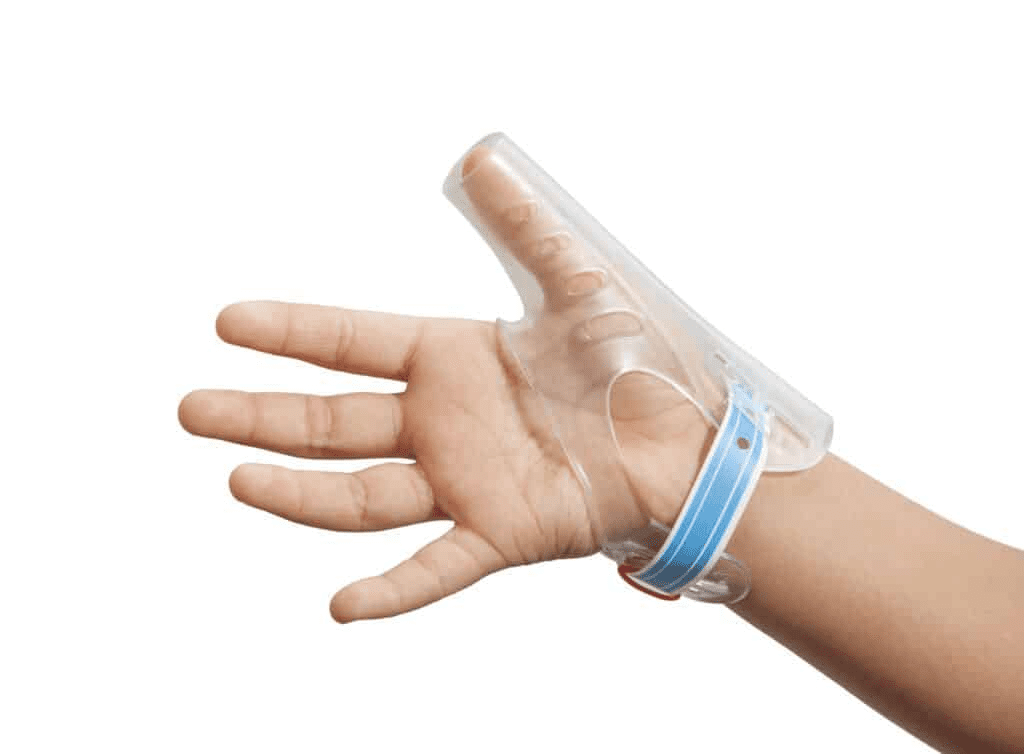
T – guard is a transparent cover used over the thumb; it is made of silicon. This is mainly used to avoid direct skin contact from the mouth. The best part is – it is medicated and suggested by experts. So, what happens when a child looks at their thumb, it seems normal. But when they suck it, it tastes unusual, which makes them uncomfortable, and in this manner, this habit moves away.
#6. Explain Why Thumb Sucking Is Terrible And Why They Should Stop It.
A happening conversation can always be helpful. You should talk to your toddlers and tell them the cons of thumb-sucking. Explain them via examples.
Use YouTube; show them graphics and colorful cartoon videos which say no to thumb-sucking. This could be very motivating, and they will surely stop thumb-sucking. Kids are bright, and we provide them with data to prove it. How harmful thumb sucking can be.
#7. Praise, don’t punish
Celebrate little wins. If they are decreasing the amount of thumb sucking, offer them rewards. It can be a short trip, new toys, a visit to a friend, etc.
Research says that Punishment can give birth to aggression in your child. So, replace punishment words with praise. Start praising them while they go to bed since thumb-sucking is more harmful and addictive at bedtime.
#8. Bitter Nail Polish
Bitter nail polish is bad-tasting nail paint applied over toddlers’ nails. Doctors do not recommend this aggressive method as nail polish can contain harmful chemicals. So, kids avoid sucking their thumbs.
This obstacle of bitter nail paint is used for those thumbsuckers who are not that habitual of thumb-sucking and just need a gentle reminder to avoid doing it.
#9. Try Handstopper

The hand stopper is made up of non-harmful material. It is suggested by the professional. It is a better option when compared to T-guard or bitter nail polish. Furthermore, it covers the child’s elbow and restricts palm movement to the mouth.
This does irritate toddlers but is effective. This has been proven as the best technique for chain thumbsuckers. Some of the handy and popular hand stopper brands are-
- NIPIT Thumbstopper (especially for the kids between 2-7)
- Thumbusters Thumbstopper
- Premium Pediatric Child Elbow
- Heyshapeing Thumb Sucking stop for kids (age 1-7)
10. If Everything Fails, See The Doctor
Until the age of 3, thumb sucking is normal. But after that, it is something which needs your attention. Whereas, by the age of 5, it becomes a serious concern. You should visit the dentist as it hinders teeth growth.
A doctor will explain the toddler more effectively via charts and PPTs. Since they are masters in the field, they will suggest the best tactics for the oral development of your ward.
If Not Stopped, What does Thumb Sucking in Children Leads to?
When elders and mature parents say thumb-sucking can lead to more significant problems, they aren’t lying! A simple lousy thumb-sucking habit can lead to many health and social problems. Let us look at a few critical concerns related to health and well-being, led by thumb-sucking patterns in infants and toddlers:
#1. Open Bite
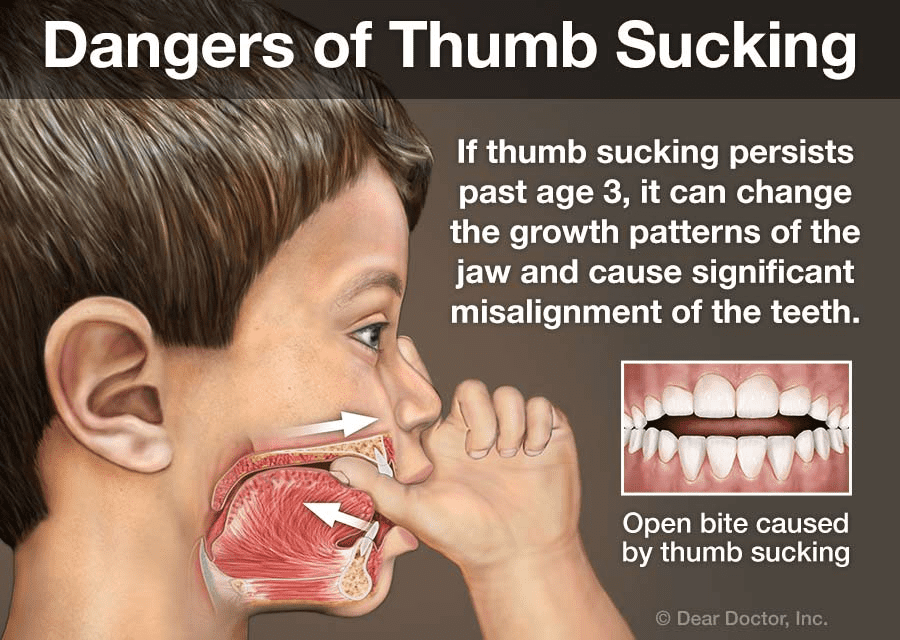
The most unwanted side effect caused by thumb sucking is Malocclusion. Malocclusion is the problem of teeth misalignment that affects the facial structure and is visible even when the mouth is closed.
Two such types are called Open Bite and Overbite. Open Bite is the type of teeth misalignment wherein the upper and lower front tooth moves upwards, and the upper front teeth don’t touch in a closed mouth.
Such a problem will lead the child to the orthodontists and engage them in year-long treatment plans.
#2. Overbite
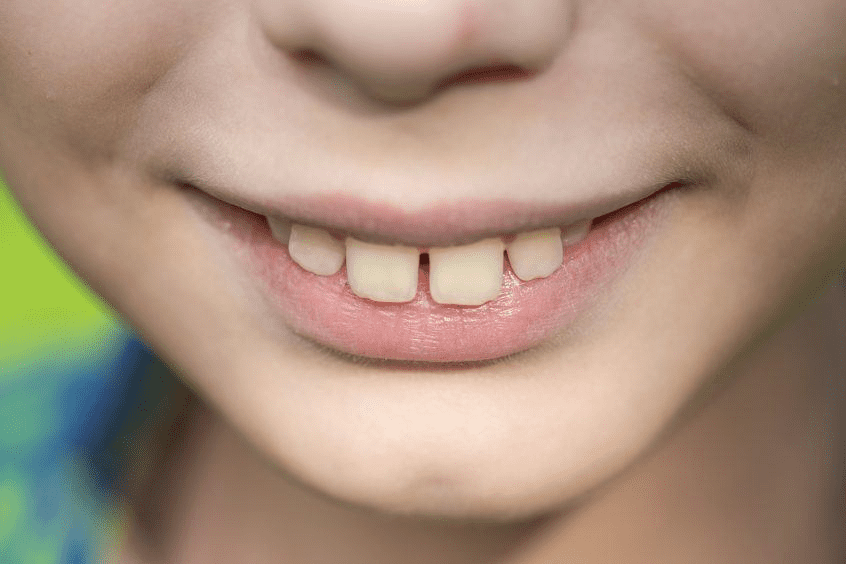
Overbite is another tooth misalignment problem. In this case, the upper front teeth move upwards and completely cover the lower teeth in the closed mouth. While the upper teeth usually touch the lower ones, the upper teeth overlap in this condition.
This overlapping teeth problem, where metal brace treatment becomes a challenge too! This condition also affects the shape of the smile and face, which might require headgear treatments.
#3. Skin Issues
Thumb sucking is a process where a child’s saliva is in direct contact with the thumb, leading to skin problems.
The constant sucking mechanism reduces moisture, resulting in dry and cracked skin thumbs with peeling and ingrowth problems. In extreme cases, the skin might start bleeding too!
Thus, parents need to highly discourage the thumb-sucking habit in their child by looking at the skin problems it caters to as early as possible. You could bandage the thumb or cover it in other ways to avoid the problem.
#4. Speech Impediment
Not just dental and skin problems, the thumb-sucking habit affects speaking habits too!
The most common symptom of thumb sucking is lip sync and speech problems. They might find it challenging to pronounce consonants like ‘D’ and ‘T.’
The problem could be challenging to treat even with proper dental care, which might not allow your child to communicate effectively. All of this might eventually lead to anger, irritation, and frustration.
#5. Social Issues
Unimproved thumb-sucking habits can target your kid amongst peers. Before becoming a dental or skin problem, it can turn out to be a social problem for your child.
While your child grows up with the habit, it can be a judging factor for others. It affects your child’s personality and might be inappropriate during development.
You need to help your child resolve the habit and take it to the pediatric dentist as soon as possible.
Pacifiers: Are They Safe?
Most babies with intense thumb-sucking devices are given pacifiers as an alternative. Pacifiers are the substitute for nipples that look like that and are made of silicone, rubber, and plastic. The question here is, are they a safer alternative for your child’s thumb-sucking habit?
Pacifiers are excellent for distracting the child and give you comfort from trying to control their thumb-sucking habit. But, pacifiers might increase the risk of middle ear infections in your infant while also causing dental problems if not cleaned properly.
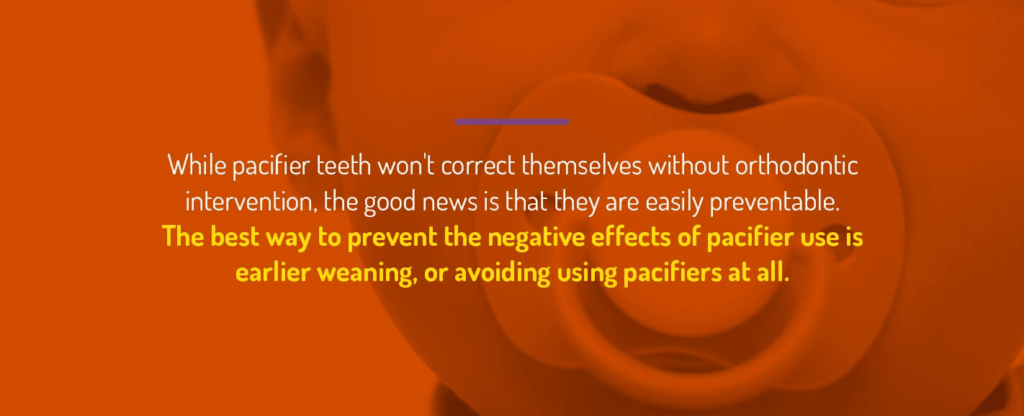
In most cases, parents should avoid giving pacifiers to their infants. It nowhere helps in getting rid of the habit, besides avoiding them sucking their thumb. The risk of the pacifier stands on top of the convenience as your child grows up.
Can a Doctor Help? Question To Ask Your Doctor

Yes, a doctor can help if the thumb-sucking habit of your infant is concerning. A healthy conversation between your toddler and the doctor can sort it out. Since they are experts in the industry, they do have colorful charts, presentations, and models for explaining your child in a better way.
Also, Psychology says we tend to listen to strangers more than our family members. In this manner, chit-chat with a dentist is essential for increasing awareness regarding your child’s oral health, which can be hampered by thumb-sucking.
Apart from consultancy, the following should be the Questions to ask your doctor:
- Which is a better-Pacifier, Finger Cover or Hand stopper?
- At what age does thumb-sucking become a severe problem?
- What are the ill effects of thumb sucking?
- Which brand’s pacifier is best?
- What if my infant does not stop sucking their thumb?
Conclusion
As you see, thumb-sucking can be dangerous as children grow up. Try out a few remedies in the blog above and see the results! A child should stop sucking their thumb anywhere between 6 months to 2 years. If they don’t, take a look at signs that are triggering their thumb-sucking.
FAQ’s
#1. How do you stop your child’s thumb-sucking habits naturally?
Although, this habit is not easy to forget. But some of the natural and easy steps to help your child stop thumb sucking could be –
- Take baby steps and start slowly.
- Tell them superheroes do not want their thumbs to suck.
- Don’t scold them.
- Explain its cons.
- Appreciate little wins.
#2. What are the Thumb sucking Guards?
There are many thumbs-sucking guards to stop the habit in kids. It includes –
- Pacifiers
- T- guard
- Handstopper
- One can even try tying cotton cloth over the thumb.
- Apply bitter nail paint.
#3. What is accelerated thumb sucking?
Thumb sucking is natural, and studies show that toddlers do this even in the womb. This acceleration is due to anxiety and boredom, making them feel safe. Moreover, since breastfeeding resembles nipple sucking while going to sleep, thumb sucking is its replacement.
#4. What are the side effects of thumb sucking?
Following are the side effects –
- Skin infections due to constant contact with saliva.
- It hampers teeth growth.
- As the child grows, thumb-sucking can often attract teasing from other children or, in worst cases, bullying.
- It can lead to the destruction of the thumb shape.
- At an early age, it is the reason behind stammering.
#5. At what age thumb sucking becomes a problem?
The habit of thumb tucking is regular, as infants relate it with nipple sucking while their mothers are breastfeeding. But, this becomes a problem if they keep doing it more often.

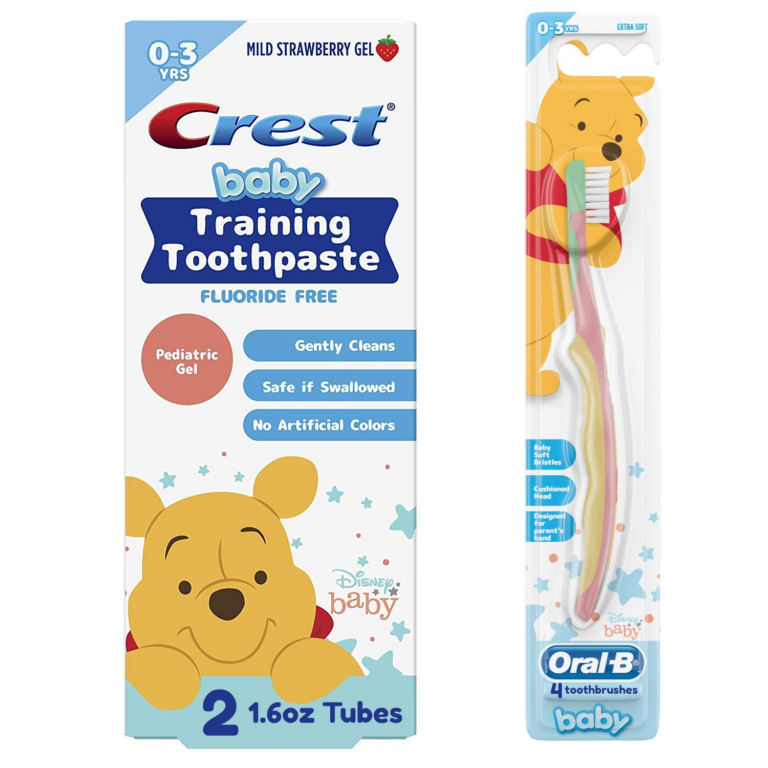
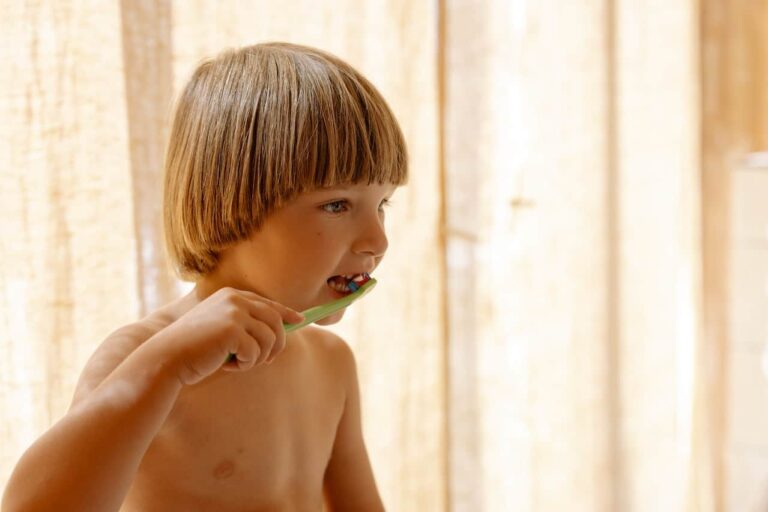
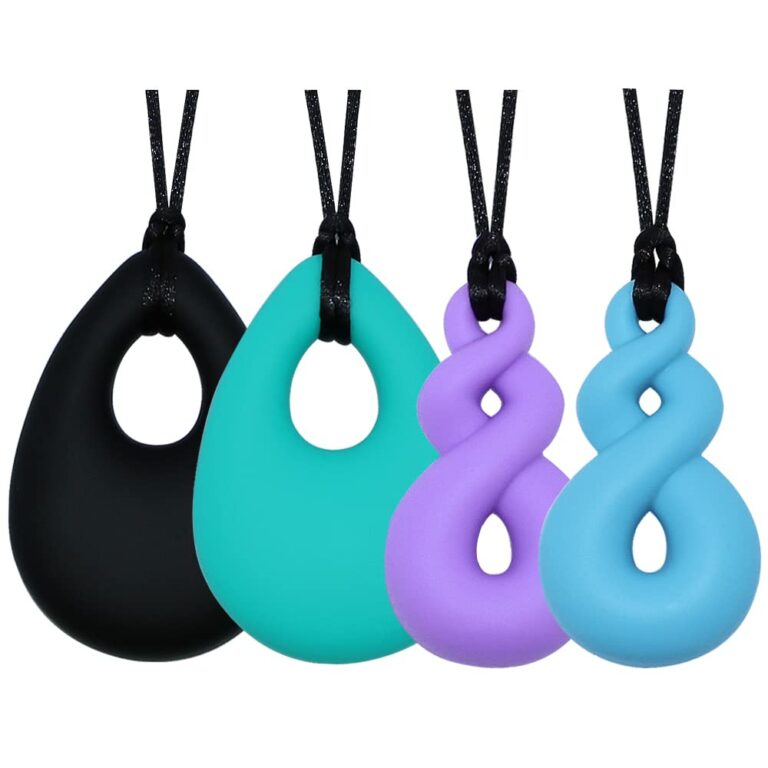
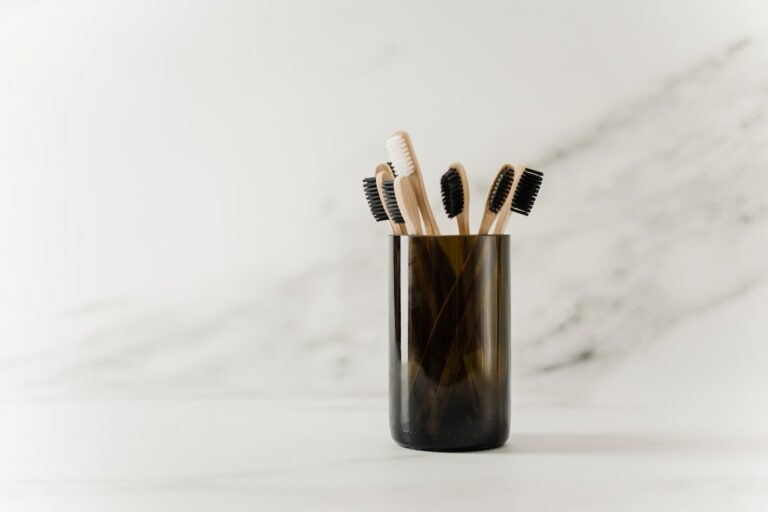

![13 Best Mouth Wash for Kids [Buying Guide]](https://www.kidsdentalguard.com/wp-content/uploads/2022/01/Best-mouth-wash-for-kids-768x403.jpg)